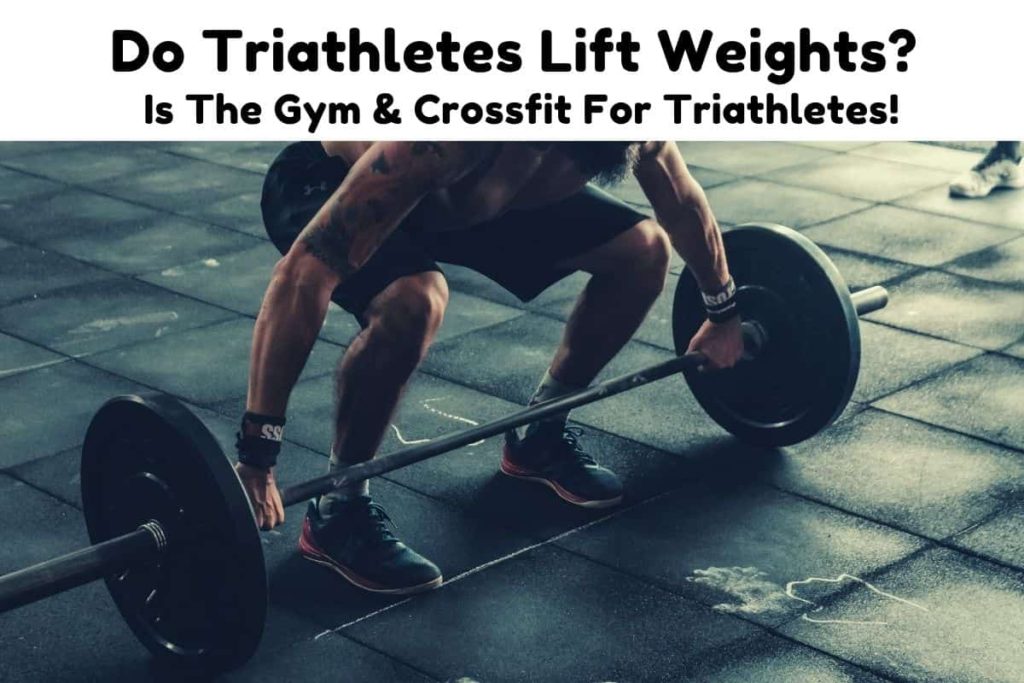Training for triathlons can take up a huge amount of time. It can be difficult to decide how to split your training time between sports.
Triathletes don’t just face tough decisions between which sport to practice, however. If you read any training manual and guide you’ll be under the impression that triathletes have either infinite time or infinite energy to train – it must be the only way that we could fit in the demands and suggestions made for us.
Intense, half-hour warm-ups and cool-downs, stretching, mobility sessions, yoga, cross-training – it can be difficult to know which training sessions are important to prioritize.
The cross-training type that is most commonly suggested is weight or strength training. But when you look at pro triathletes, this doesn’t seem to fit. They don’t seem to have well-developed muscles and have bodies clearly more suited to cardio than weight or powerlifting. For more on this, check out our post titled Can You Be Muscular and A Triathlete? Is Triathlon The Ultimate Fitness Workout!
So you may be asking if weightlifting is common amongst triathletes and whether you should be lifting too? The answer is, if you’re looking to boost your performance, you should absolutely carve out some time for strength training.
So, do triathletes do weight training? Most triathletes do at least some form of weight training. Strength training can improve strength, power, endurance, improve body composition and help correct imbalances. For triathletes looking for a competitive edge, the strength offered by regular gym sessions can be a saviour.
Strength training is more common during the off-season, when triathletes are building back up to race condition and looking to strengthen, rather than speed up. Of course, the big bonus to training during the winter for triathletes in more northern climes is that the gym is far warmer than training outside!
(Source)

Should Triathletes Lift Heavy?
In the results of a study from the International Journal of Sports Physiology and Performance, endurance athletes across a number of sports were shown to benefit from adding strength training. When it comes to triathlon, although the benefits of lifting to swimming performance are debated, the benefits of lifting to both cycling and running are not. (Source)
Until recently, the commonly accepted doctrine was to lift lightweight in incredibly high reps, often up to 30 in a single set. The theory was that these higher reps simulated endurance activity more, thereby conditioning the body to strengthen slow-twitch fibers.
It was thought that strength was developed at the cost of endurance, and triathletes often ran scared of the potential weight gain through muscular development
But lifting heavy can, in fact, significantly improve endurance performance – and not just over months but years, as strength training can strengthen tendons, ligaments, collagen and improve bone density. These will all help maintain performance well into middle age, not just through the next season.
We also recommend that you check our post Should You Workout Before or After Swimming? Pros & Cons
How Often Do Triathletes Lift Weights?
Finding time is always the problem most triathletes face when it comes to training. There are constant demands to do more training or bench out into different kinds, as well as the demands of normal life. But one session per week may be enough.
The frequency of strength training sessions should depend on your body and your training plan. During the base phase, most triathletes would benefit from around three sessions per week. However, during the race season, this can be reigned back down to one session per week. That should be enough to maintain most of the strength built up during the winter, without significantly detracting from performance or overly affecting weight.
However, if you’re rehabbing from an injury or targeting a weakness, like muscular imbalance, then you may need to visit the gym more often than other triathletes. Older triathletes should also head to the gym more often, as weight training can have huge impacts on the effects of aging and in maintaining respiratory performance.
We also recommend that you check out our post Can I Run and Lift Weights Every Day? What Are Your Options !!
Can You Train for A Triathlon in The Gym?
Although the gym can help you prepare and strengthen your body ahead of the rigours of a triathlon, you can’t train in the gym alone. For a start, there is no way to simulate open water swimming without open water swimming!
You will need exposure to riding your bike in race conditions and practice cornering, climbing, and descending.
These are incredibly difficult to replicate without top-level gym equipment
Whilst treadmills provide a pretty accurate simulation of running outside, they also lack the ability to make adjustments for things like weather or road conditions.
For more on this topic, check out our post titled ” Swim or Gym – Which Is Better? Should You Swim Before or After a Workout!
Why Should Triathletes Strength Train?
There are multiple reasons for triathletes to spend time strength training, but they boil down to; injury prevention, increasing power, equalizing power delivery, and developing better form and mechanics. Consistent lifting can help increase bone density maintain muscle mass and protect vulnerable joints from injury.
Strength training significantly increases the amount of slow-twitch fibers in the body’s muscles. These are better for endurance sports because they produce lactic acid at a much slower rate than fast-twitch fibers. Building up these muscles may cost you some sprinting speed, but it will raise your lactate threshold, meaning you can hold higher power for longer.
Many of us have a weaker leg, arm or joint. Strength training allows you to target your weakest muscle in isolation, reducing the difference between your weaker and stronger limbs or sides. On a side note, we recommend that you also check out our post “Does Cycling Build Legs Muscles & Make Them Bigger? What You Should Know!“
That improves efficiency, helping you deliver more even and consistent power output.
Here is a good video with some simple and quick strength workouts for triathletes,
Should Triathletes Bench Press?
Bench press is a particularly good exercise for weak swimmers, as it strengthens the chest. This can really improve the pull phase during the swim, making the athlete’s stroke both more powerful and more efficient.
If you’re in the gym it seems almost a crime not to bench press. But be careful – if you’re an excellent swimmer already, but a poor runner or cyclist, you would be better off spending time in the gym developing strength in muscles in the legs.
Are Deadlifts Good for Triathletes?
Many of us stay away from deadlifts. They are difficult to get right and easy to get wrong, and can be a painful fast track to injury. But triathletes should absolutely do deadlifts! In fact, some say that if triathletes only do one strength exercise, they should make sure it’s the deadlift.
The deadlift is ideal for triathletes because it is a full-body, compound, functional movement. The deadlift engages the shoulders, lats, core, back, hip, hamstrings and glutes all at the same time. Strengthening all these muscles at once is what makes deadlifts so difficult – and worth doing!
The other benefit to the deadlift is not just increased power; because it demands engagement from the whole body and mental focus in order to ensure consistent, clean reps, deadlifts make us move more deliberately, efficiently and powerfully.
Is Cross Fit Good for Triathletes?
Strength training of any kind is a positive for most triathletes, and using CrossFit intelligently could help improve strength and power, reduce muscular imbalances and hone proper form – but it would be wise to keep it to an offseason activity.
CrossFit is a high-intensity interval training program that focuses on strength and power but utilizes functional movements. Many of them are conventional strength training exercises you’ll have done before like squats, push-ups and deadlifts. But the secret to Crossfit’s success is because of the emphasis of the workouts on load, distance and speed. These can result in huge increases in power in participants. (Source)
Forms of exercise come in waves of popularity, and Crossfit is currently at the very crest, along with spinning.
Both rely on building up a strong community atmosphere, but as triathlete purists, we are always naturally suspicious of the value of highly popular forms of exercise.
Whilst the benefits amongst participants in CrossFit are notable, it’s worth bearing in mind that many have come from relatively low levels of exercise, which isn’t true of most triathletes


